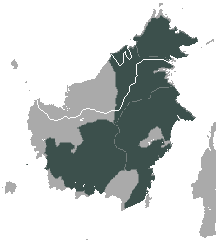Chestnut langur
| Chestnut langur | ||||||||||||
|---|---|---|---|---|---|---|---|---|---|---|---|---|

Chestnut langur ( Presbytis rubicunda ) |
||||||||||||
| Systematics | ||||||||||||
|
||||||||||||
| Scientific name | ||||||||||||
| Presbytis rubicunda | ||||||||||||
| ( S. Müller , 1838) |
The chestnut langur ( Presbytis rubicunda ) is a primate species from the group of the slender monkeys (Presbytini) that lives on Borneo . It is divided into five subspecies, which differ mainly in the color of their fur. The nominate form , P. r. rubicunda occurs in the southeast of the island south of the Mahakam River and east of the Barito River. The distribution area thus roughly covers the Indonesian province of Kalimantan Selatan and the southern half of Kalimantan Timur . P. r. carimatea lives on the Karimata Island , P. r. chrysea in a very small area in the Malaysian state of Sabah near Kinabatangan . The distribution area of P. r. ignita lies in Sarawak east of the Sungai Baram and in Kalimantan south to the Kapuas and that of P. r. rubida south of the Kapuas and west of the Barito.
features
The characteristic that gives the chestnut langurs their name is their reddish or orange-colored fur , which is a little lighter on the belly and a little darker on the hands and feet than on the rest of the body. P. r. rubicunda is chestnut brown, P. r. carimatea brick red, P. r. chrysea reddish-golden, P. r. ignita fuchsrot and that of P. r. rubida similar in color to P. r. rubicunda with a yellowish tinge and only slightly darker hands and feet. They are small, slender primates with relatively long hind legs and a long tail that is longer than the body. They reach a head body length of 44 to 58 centimeters, plus a 63 to 80 cm long tail. Males grow slightly larger, reaching 6 to 7 kilograms, while females weigh 5.5 to 6 kilograms. The head is characterized by the broad face and the tuft of hair that is present in all cap langurs. The hairless skin of the face is blue-gray, the lower lip and chin are pink.
Habitat and way of life
Chestnut langurs are only found on Borneo and smaller offshore islands such as Karimata Island. Their habitat are primary and secondary forests , gallery forests and swamp forests . The species occurs mostly at altitudes of less than 1200 and almost never at altitudes above 2000 meters.
Like all old world monkeys, they are diurnal and live mainly on trees. They live in groups of up to 13 animals made up of a male, several females and their offspring. The remaining males live solitary or form bachelor groups. The territory of each group is marked with loud screams that sound like “ka-ka-ka-ka-ka-ka-ka-ka” and can be heard hundreds of meters away. However, with the exception of the core area, the usually 30 to 90 hectare areas can overlap. The diet of these animals consists of young leaves (more than a third), seeds (approx. 30%), fruits (approx. 20%), flowers (approx. 10%) and insects (less than 2.5%). Chestnut langurs breed all year round. The young are white at birth. You will be weaned after about 15 months. Females become sexually mature at two years of age.
Systematics
The chestnut langur was described as Semnopithecus rubicunda by the German naturalist Salomon Müller in 1838 . His next of kin within the genus of surili ( Presbytis ) are not the four remaining surili of Borneo, but the Java langur ( P. comata ) and the Sumatran species Black White Kammlangur ( P. bicolor ), Sumatran langur ( P. melalophos ) , Southern Comb langur ( P. mitrata ) and Black Comb langur ( P. sumatrana ).
Danger
The species is likely to be common compared to other Southeast Asian primates, the IUCN lists it as not endangered. However, this only applies to the subspecies P. r. rubicunda , P. r. ignita and P. r. rubida , which are also found in numerous protected areas. For P. r. carimatea and P. r. chrysea no data are available on the endangerment and there are also no protected areas in their areas of distribution.
literature
- Thomas Geissmann : Comparative Primatology. Springer-Verlag, Berlin et al. 2003, ISBN 3-540-43645-6 .
Individual evidence
- ↑ a b c d e f Elizabeth L. Gadsby, Colin P. Groves, Aoife Healy, K. Praveen Karanth, Sanjay Molur, Tilo Nadler, Matthew C. Richardson, Erin P. Riley, Anthony B. Rylands, Lori K. Sheeran , Nelson Ting, Janette Wallis, Siân S. Waters & Danielle J. Whittaker: Family Cercopithecidae (Old World Monkeys). Page 634 in Russell A. Mittermeier , Anthony B. Rylands & Don E. Wilson : Handbook of the Mammals of the World: - Volume 3. Primates. Lynx Editions, 2013 ISBN 978-8496553897
- ↑ Presbytis rubicunda in the endangered Red List species the IUCN 2006. Posted by: A. Eudey & Members of the Primate Specialist Group, 2000. Retrieved on April 6 of 2008.
